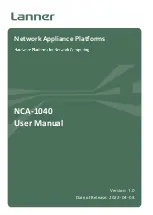
RCB-F9T - Integration manual
The NavIC L5 signal is supported by the RCB-F9T-1, but not enabled in the default GNSS
configuration. SBAS is also supported but not enabled by default as it is not recommended for timing
applications.
For more information about the default configuration, see the applicable interface description [
3.1.3 Default interface settings
Interface
Settings
UART Output
115200 baud, 8 bits, no parity bit, 1 stop bit. NMEA
GGA, GLL, GSA, GSV, RMC, VTG, TXT
(and
no UBX) messages are output by default.
UART Input
115200 baud, 8 bits, no parity bit, 1 stop bit. UBX, NMEA and RTCM 3.3 messages are enabled
by default.
Table 1: Default configurations
Refer to the applicable interface description [
] for information about further settings.
By default the RCB-F9T outputs NMEA messages that include satellite data for all GNSS bands
being received. This results in a higher-than-before NMEA load output for each navigation period.
Make sure the UART baud rate being used is sufficient for the selected navigation rate and the
number of GNSS signals being received.
3.1.4 Basic receiver configuration
This section summarizes the basic receiver configuration most commonly used.
3.1.4.1 Communication interface configuration
Several configuration groups allow operation mode configuration of the various communication
interfaces. These include parameters for the data framing, transfer rate and enabled input/output
protocols. The configuration groups available for each interface are:
Interface
Configuration groups
UART1
CFG-UART1-*, CFG-UART1INPROT-*, CFG-UART1OUTPROT-*
Table 2: Interface configurations
3.1.4.2 Message output configuration
The rate of the supported output messages is configurable.
If the rate configuration value is zero, then the corresponding message will not be output. Values
greater than zero indicate how often the message is output.
For periodic output messages the rate relates to the event the message is related to. For example,
the UBX-NAV-PVT (navigation, position, velocity and time solution) is related to the navigation
epoch. If the rate of this message is set to one (1), it will be output for every navigation epoch. If the
rate is set to two (2), it will be output every other navigation epoch. The rates of the output messages
are individually configurable per communication interface. See the CFG-MSGOUT-* configuration
group.
Some messages, such as UBX-MON-VER, are non-periodic and will only be output as an answer to
a poll request.
The UBX-INF-* and NMEA-Standard-TXT information messages are non-periodic output messages
that do not have a message rate configuration. Instead they can be enabled for each communication
interface via the CFG-INFMSG-* configuration group.
UBX-22004121 - R01
3 Receiver functionality
Page 8 of 64
C1-Public
Early production information








































